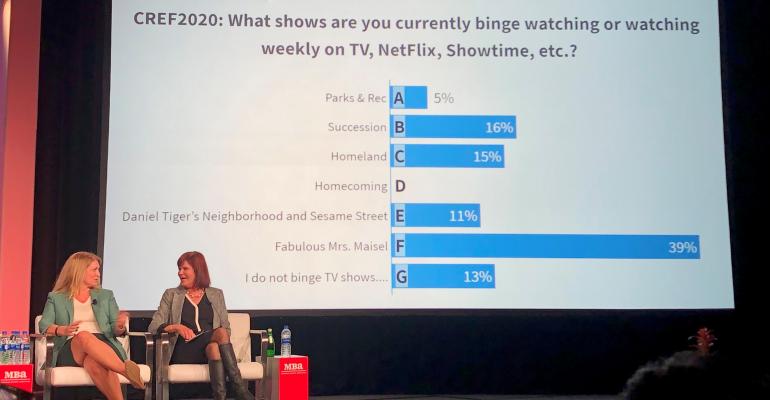This week kicked off the annual Mortgage Bankers Association/Commercial Real Estate Finance conference in San Diego. Among the hot topics discussed during Monday’s panel sessions were the rising volume of collateral debt obligations (CLO), the impact of rent regulations on multifamily lending and whether proptech is going to make commercial mortgage bankers obsolete. Here are some takeaways from Monday’s discussions:
- One of the areas where commercial mortgage lenders are starting to see a substantial number of risky transactions taking place in today’s market are CLOs. “The market is really letting almost anyone play in the CLO space,” noted Michael Comparato, managing director and head of commercial real estate with Benefit Street Partners, who served as one of the panelists during the “Creative Capital: New Players Continue to Grow Their Footprints” discussion. Comparato also said that he expects to see more risk appear in the market over the next year “just because we’re seeing a lot of ridiculous deals,” such as deals in tiny markets where commercial assets are trading at 25 percent more this year than they did the year before. “This kind of stuff keeps me up at night,” Comparato said.
- However, the participants in the “Creative Capital” panel were not as concerned about retail properties and office buildings heavily occupied by WeWork as might be expected given recent news headlines. Benefit Street Partners, Morrison Street Capital and Square Mile Capital Management have all closed loans on retail assets in the past year, though they may have leaned more toward grocery-anchored shopping centers than regional malls. Still, according to Jeffrey Fastov, managing director with Square Mile Capital Management, “We are profoundly confused by [retail]. Out of 200 loans, we did three that were retail.”
- When it comes to WeWork-occupied office properties, the private equity lenders feel those buildings may currently be under-valued and may therefore present an attractive investment opportunity. However, the risk they carry would have to be reflected in the deal terms. Peter Smith, managing director and head of originations with TPG Real Estate Finance Trust, mentioned that his team looked at a potential deal that morning that involved an office building where WeWork leased about 34 percent of the space. TPG declined the transaction because the firm’s executives felt it called for a wider spread than the borrower was looking for.
- The outlook for the multifamily sector remains bright. While there has been a high amount of new supply coming on the market, there is demand to fill it and vacancies have been very tight, according to Jamie Woodwell, vice president of research and economics with the MBA. “We are expecting multifamily lending to increase by about 9 percent this year,” he noted during a session on “Multifamily Matters: GSE Trends and Apartment Finance.” In addition to institutions, newer sources of investment coming into the multifamily space have included foreign money and family offices. “You are seeing a lot of that among the uber wealthy and it’s not an insignificant amount of money,” said Hilary Provinse, executive vice president and head of mortgage banking at Berkadia.
- However, the increasing number of states and municipalities around the country implementing rent regulations is giving multifamily lenders some pause. “We’re expecting that to be happening in more markets,” noted Robert G. Levin, senior vice president, multifamily customer engagement with Fannie Mae. “And I think we will see investors—I don’t want to say flee those markets—but I think we will see investors make different choices.” Earlier, CIT’s Matt Calligan mentioned that a rent-regulated building in the Rego Park section of Queens that had come on the market in February of 2019 finally sold last month at a 35 percent discount to its original price. Rent regulation “is a disaster in New York,” when it comes to multifamily investment and lending, Calligan noted.
- Outside of the markets facing rent regulation, multifamily lenders see little risk to their business right now. “In the core [multifamily] businesses, there’s nothing that’s making me nervous, especially on the middle-market, workforce side, so maybe [this cycle] is a double header,” said Deborah L. Jenkins, executive vice president and head of multifamily division with Freddie Mac. According to Michael McRoberts, managing director with PGIM Real Estate Finance, “I think we can roll for a while and have a period of time when returns are not as good as they have been, but they are still fine.”
- While commercial mortgage bankers say their companies are trying to keep up with the latest proptech trends to make doing business more convenient for customers, they are not afraid technology is going to eventually replace them entirely. “People want personal relationships, they want to know where our minds are,” noted Benjamin Stacks, commercial real estate line of business executive with BankUnited. “The tech stuff is important, but am I going to be intermediated by a commercial mortgage app? Maybe, but it’s not going to happen any time soon.” According to Brad J. Dubeck, market executive with the New York/New Jersey commercial real estate banking team at Bank of America Merrill Lynch, technology will do away with things like paper loan documents and allow commercial banking customers to complete transactions online in the same manner that personal banking customers already do today. “Tomorrow, you are going to do everything on your smartphone—except call your banker and ask for the loan,” Dubeck said.
0 comments
Hide comments

